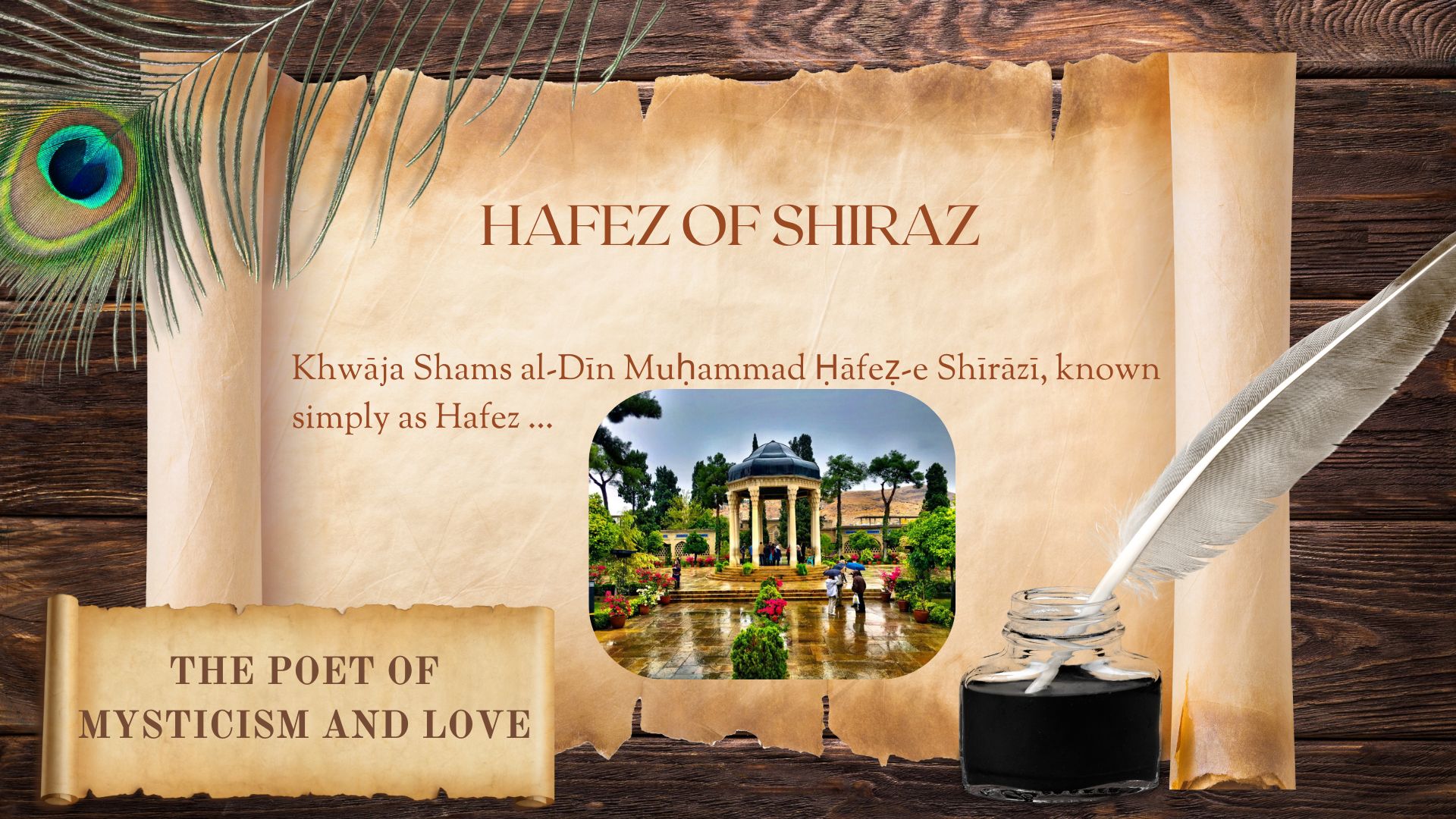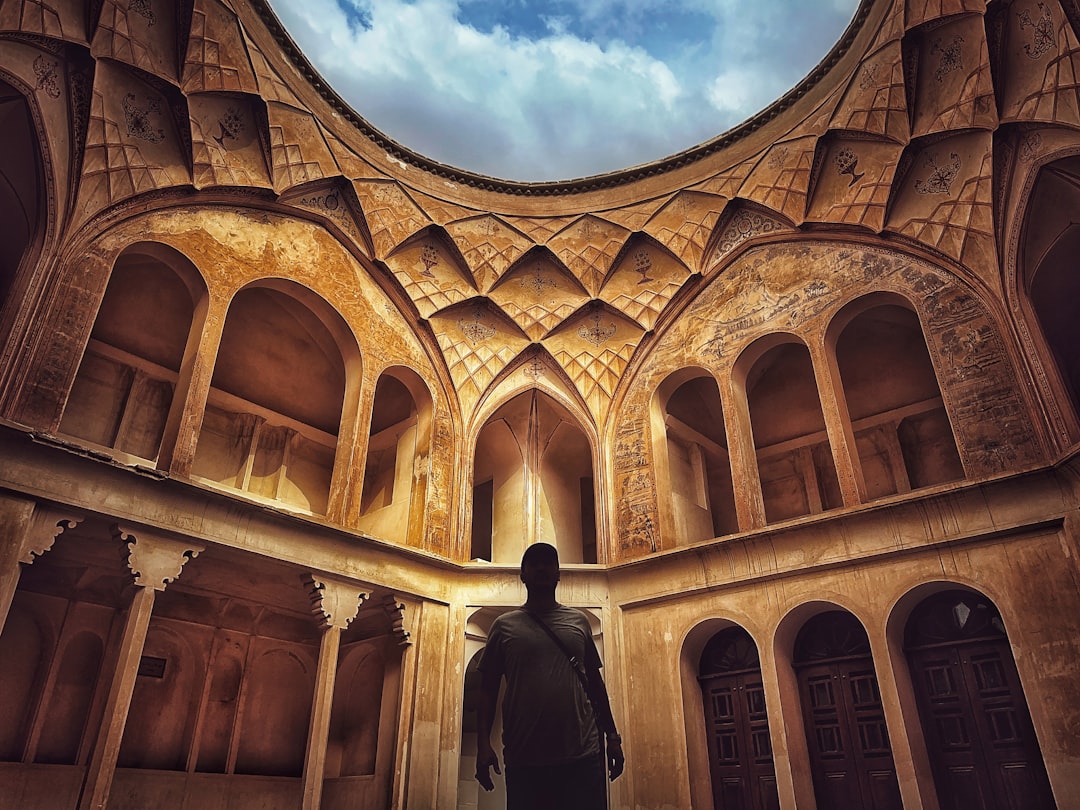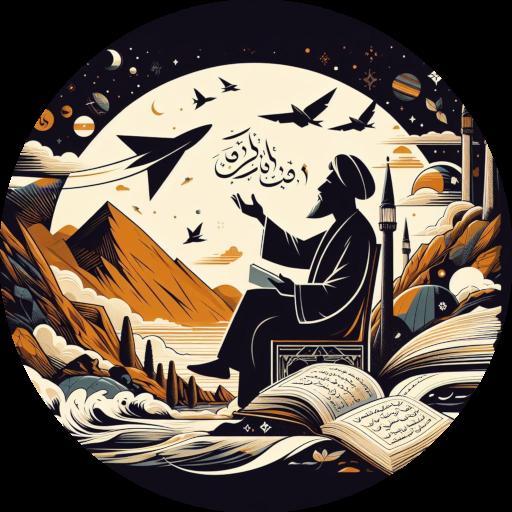Khwāja Shams al-Dīn Muḥammad Ḥāfeẓ-e Shīrāzī, known simply as Hafez, was born in Shiraz, Persia (modern-day Iran), around 1315 CE and lived until about 1390 CE. He is celebrated as one of the greatest figures in Persian literature and is regarded not only as a master of lyric poetry but also as a voice that bridges spirituality, philosophy, and human emotion.
Hafez’s life unfolded during a turbulent era marked by political unrest, Mongol invasions, and shifting dynasties. Despite these upheavals, Shiraz, the city of his birth and death, remained a center of culture, art, and learning. Hafez grew up in this vibrant atmosphere, immersing himself in the study of theology, Qur’anic recitation, and Persian literary tradition. His name "Hafez," meaning "one who has memorized the Qur’an," reflects his mastery of the sacred text.
Though deeply rooted in Islamic mysticism (Sufism), Hafez’s poetry transcends rigid dogma. His verses weave together themes of divine love, earthly passion, the fleeting nature of life, the hypocrisy of the pious, and the intoxication of wine, used as a metaphor for spiritual ecstasy. This duality, sacred and profane, mystical and human, is what gives his poetry its timeless depth.
Hafez never sought political power nor patronage aggressively, but his wit and artistry made him both admired and feared by rulers. His poetry often critiques hypocrisy among religious and political elites while celebrating the liberating spirit of love and joy.
To this day, Hafez holds a unique place in Persian culture. His Divan (collected works) is not just a book of poetry, it is a cultural touchstone, often used in fortune-telling rituals (fal-e Hafez), recited in gatherings, and cherished as a guide for wisdom and inspiration. He is considered the national poet of Iran, but his influence extends far beyond, inspiring figures such as Goethe, Emerson, and Nietzsche.
Hafez of Shiraz thus remains more than a poet; he is a voice of timeless longing for truth, beauty, and freedom, an eternal companion to those seeking meaning in life.
Shiraz in the Time of Hafez
In the 14th century, Shiraz stood as a cultural jewel in Persia, even while much of the region was shaken by wars, invasions, and political instability. It was often called the “City of Roses and Nightingales”, a reputation it still holds today, and it became known as a safe haven for poets, scholars, and mystics.
Political Context
When Hafez was born, Persia was still reeling from the destructive Mongol invasions of the previous century. The Ilkhanid dynasty had collapsed, and the region fractured into smaller dynasties. Shiraz came under the rule of the Injuids and later the Muzaffarids, both of whom were local powers. While conflict often plagued the region, Shiraz itself was spared from some of the worst devastations of war, allowing culture and scholarship to flourish.
One reason Shiraz escaped large-scale destruction was the wise diplomacy of its rulers, who negotiated peace or paid tribute to avoid ruin at the hands of conquerors like Timur (Tamerlane). This relative stability made the city a refuge for learning and the arts, even as chaos surrounded it.
Cultural and Intellectual Life
Shiraz was a thriving center of Persian culture, known for its schools, gardens, mosques, and libraries. It was home not only to Hafez but also to other great poets such as Saadi of Shiraz (who lived a century before him). In Hafez’s time, scholars studied theology, philosophy, astronomy, and literature, blending Persian traditions with Islamic thought.
Music and wine were also integral parts of Shirazi life, despite religious restrictions. Taverns, gardens, and Sufi gatherings provided inspiration for much of the imagery found in Hafez’s poetry: the cupbearer, the tavern, the blooming rose, and the nightingale’s song.
Social and Spiritual Environment
Shiraz was also a city of contradictions. It had both devoutly religious scholars and Sufi mystics who celebrated divine love through poetry and music. Hafez often found himself at the crossroads of these worlds. His verses reflect both the deep spirituality of Sufism and sharp critiques of religious hypocrisy among the city’s orthodox clerics.
For the people of Shiraz, poetry was not an elite pastime, it was part of everyday life. Verses were recited in gatherings, exchanged in conversation, and inscribed on walls and books. In this environment, Hafez’s words resonated widely, securing his place as the city’s, and later the nation’s, beloved voice.
The Divan of Hafez
The Divan of Hafez is the collected body of Hafez’s lyrical poetry, preserved and cherished for more than six centuries. Unlike an epic or a long narrative, his Divan consists mostly of ghazals, short, highly musical lyric poems, typically five to fifteen verses long, each one a self-contained meditation on love, spirituality, longing, or irony.
Compilation of the Divan
Hafez himself did not prepare his poems into a formal book. After his death around 1390 CE, his students and admirers collected his works into what became the Divan of Hafez. Different early manuscripts exist, and not all contain the same poems, which is why modern editions may vary slightly in their content and ordering.
Despite this variation, the Divan has consistently preserved the essence of Hafez: his wit, depth, and unique blending of earthly and spiritual imagery. Over the centuries, countless scribes, calligraphers, and later printers have kept his verses alive, often adorning them with exquisite Persian calligraphy and illumination.
Themes of the Divan
Hafez’s Divan defies simple categorization because it speaks on multiple levels at once:
-
Love and Beauty – Many of his ghazals celebrate beloved figures, sometimes interpreted as earthly lovers, sometimes as symbols of the Divine.
-
Wine and the Tavern – The wine cup and tavern, recurring images in his verses, are metaphors for spiritual intoxication, joy, and freedom from rigid orthodoxy.
-
Mysticism and Sufism – His poetry reflects a Sufi vision of the world, where love is the path to union with God, and the material world is but a veil over deeper truths.
-
Irony and Satire – Hafez often critiques hypocrisy, especially among self-righteous clerics or corrupt rulers, using humor and subtlety to veil his sharpest barbs.
-
Fate and the Transience of Life – His verses remind readers of life’s fleeting nature, urging them to embrace joy and live fully in the present moment.
This layered richness is why the Divan continues to be read differently by scholars, mystics, lovers, and ordinary people alike.
Role in Persian Culture
The Divan of Hafez is not just a literary treasure; it is a living book. In Iran, it is found in nearly every household, often alongside the Qur’an. It is common to perform “fal-e Hafez” (fortune-telling with Hafez), where one opens the Divan at random and interprets the first poem as guidance for a question or situation.
Beyond Iran, the Divan influenced world literature. Johann Wolfgang von Goethe, inspired by Hafez, wrote his West-Eastern Divan in dialogue with him. Emerson called Hafez “a poet for poets,” praising his universality.
The Divan of Hafez endures because it transcends time: it is at once Persian and universal, mystical and worldly, joyful and sorrowful, a mirror reflecting the complexity of the human soul.
Selected Ghazals of Hafez (in English Translation)
1. On Wine and Spiritual Freedom
Bring me the cup of wine, the first since Creation’s dawn,
For Love appeared, and turned the temple into a tavern.
The pious shake their heads, but in truth,
The tavern is closer to God than the hypocrite’s prayer.
(Translated from a ghazal where Hafez contrasts joy and honesty with false piety.)
2. On the Beloved and Divine Love
I am the slave of Love, and free from both worlds.
I seek neither heaven nor hell, only the face of the Beloved.
Every breeze carries her scent,
And every rose is but a mirror of her beauty.
(A classic Sufi interpretation of divine love in human imagery.)
3. On Fate and the Fleeting Nature of Life
O Cupbearer, set the wine before me,
For the wheel of heaven spins and passes swiftly.
Life is a fleeting dream,
Drink, before the dream is gone.
4. On Hypocrisy and True Faith
Do not be fooled by the preacher’s piety,
For he hides desire beneath his cloak.
Come to the tavern, if you seek truth,
For there, no one wears a mask.
These short examples show why Hafez has been loved for centuries: his poetry speaks in layered meanings, earthly pleasure, spiritual ecstasy, and sharp social critique, all at once.
Full Ghazal Examples from Hafez (in English Translation)
1. The Tavern and Divine Intoxication
Last night, the Magian elder brought me wine,
He whispered: “Take this cup, for the world is but an illusion.”
He said: “O Hafez, abandon hypocrisy and fear,
For only through love will you find the path to God.”
Where the pious see sin, the lovers find truth,
The tavern is holy, if the heart is sincere.
Bring the wine, for this fleeting world will not remain,
Drink deep, before the dawn takes it away.
2. The Beloved as Divine Presence
My heart is lost in the tresses of the Beloved,
And my soul is enslaved by the curve of her brow.
O breeze, if you pass by the street of the Friend,
Deliver my greetings, and the tale of my tears.
Without her, the garden has no roses,
Without her, the morning has no light.
I am Hafez, drunk on the wine of her love,
Her beauty is the mirror of the Eternal.
3. On Fate and the Fragile World
O dawn wind, bring fragrance from the Beloved’s hair,
For the garden of life blossoms only for a moment.
Do not boast of riches, palaces, or fame,
For all is dust, swept away by fortune’s hand.
Yesterday, a king sat upon the throne,
Today, a beggar rests in his place.
Drink the wine, for the wheel of heaven turns,
And no man can halt its spinning.
4. A Prayer for Freedom from Hypocrisy
From the hand of the preacher I seek no sermon,
From the veil of the hypocrite, no guidance comes.
Give me the wine of love from the cupbearer’s hand,
For one sip reveals what a lifetime of prayer conceals.
Hafez, do not fear the gossip of the devout,
The Friend knows your heart, and that is enough.
These translations preserve both the lyrical beauty and the layered meanings of Hafez’s ghazals. Each can be read as a love poem, a spiritual meditation, or a critique of the times.
Hafez’s Influence on Western Poets and Culture
Though deeply rooted in Persian mysticism and culture, Hafez’s poetry has transcended borders, languages, and centuries. From the 18th century onward, translations of his Divan began to circulate in Europe, and his verses found eager admirers among some of the greatest Western poets, philosophers, and thinkers.
Goethe and the West-Eastern Divan
Perhaps the most famous Western admirer of Hafez was Johann Wolfgang von Goethe (1749–1832). When Goethe encountered translations of Hafez’s poetry, he was profoundly moved by the Persian poet’s lyrical genius and spiritual depth. Inspired, he composed his West-östlicher Divan (West-Eastern Divan), a collection of poems written in dialogue with Hafez across time and culture. Goethe hailed Hafez as his “twin” and praised him as a poet whose voice belonged not just to Persia, but to all humanity.
Emerson and the Transcendentalists
In America, Ralph Waldo Emerson (1803–1882) found in Hafez a kindred spirit. Emerson called him “the poet’s poet,” admiring his fearless wit, his celebration of joy, and his disdain for hypocrisy. Emerson even introduced Hafez to American audiences through essays and lectures, presenting him as a universal poet whose words embodied freedom of thought and the search for higher truth. Other Transcendentalists, including Henry David Thoreau, also drew inspiration from Hafez’s mystical and natural imagery.
Other Western Admirers
-
Nietzsche admired Hafez’s ability to embrace both joy and suffering, seeing in him a model of life-affirmation.
-
Tennyson and Matthew Arnold, leading English poets, were influenced by the musicality and mystical themes in Persian verse, with Hafez as a central figure.
-
In France, writers such as André Gide and Charles Baudelaire resonated with Hafez’s blending of sensuality and spirituality.
Influence Beyond Literature
Hafez’s presence in the West was not limited to literature. His poetry entered European salons, where Persian verses were read and admired. Orientalist scholars and translators such as Sir William Jones and Joseph von Hammer-Purgstall helped introduce his works to new audiences, shaping the West’s image of Persian culture.
In modern times, Hafez’s verses have been quoted in philosophy, psychology, and even pop culture. His poems continue to inspire musicians, artists, and spiritual seekers worldwide.
Why Hafez Resonates in the West
Western readers were drawn to Hafez for several reasons:
-
His universal themes of love, beauty, truth, and the brevity of life.
-
His defiance of dogma and hypocrisy, which appealed to free-thinking writers.
-
His ability to merge mystical depth with lyrical simplicity, making his verses accessible yet profound.
In this way, Hafez became not only a voice of Persian culture but also a global poet , one whose words have entered the literary and cultural DNA of the West.
Hafez’s Legacy in Persian Culture
More than six centuries after his death, Hafez of Shiraz remains a central figure in Iranian cultural, spiritual, and everyday life. Unlike many poets whose works are studied mainly in classrooms, Hafez’s Divan lives in the homes, hearts, and voices of ordinary people across Iran.
The Divan in Every Home
In Persian households, the Divan of Hafez is almost as common as the Qur’an. Families often keep a beautifully bound copy, sometimes decorated with calligraphy and illumination. The book is not just for reading but for consultation, reflection, and inspiration.
Fal-e Hafez: Divination by Poetry
One of the most cherished traditions is the practice of fal-e Hafez (literally, “Hafez’s fortune”). When faced with a question, uncertainty, or decision, Iranians open the Divan at random and interpret the poem on that page as guidance. This ritual is especially popular during Nowruz (the Persian New Year), when families gather and perform fal-e Hafez together. It reflects the deep trust people place in Hafez’s words as a mirror of wisdom and destiny.
Celebrations and Gatherings
Hafez’s tomb in Shiraz, known as the Hafezieh, is one of the most visited cultural and spiritual landmarks in Iran. Each year, on October 12 (Hafez Day in Iran), admirers gather there to recite his poetry, play music, and celebrate his life. The site has become a symbol of Persian identity and a place where poetry, history, and spirituality converge.
Everyday Language and Identity
Hafez’s verses have also seeped into the Persian language itself. Many Iranians quote lines from his poems in conversation, proverbs, and speeches, sometimes playfully, sometimes solemnly. His imagery of the rose, the nightingale, the tavern, and the beloved are instantly recognizable cultural symbols.
A Symbol of Freedom and Humanity
In times of joy, sorrow, or political struggle, Iranians have turned to Hafez for comfort and strength. His critiques of hypocrisy and his embrace of love, beauty, and truth give him a timeless relevance. For many, Hafez represents the voice of freedom, freedom of thought, spirit, and heart.
Hafez is thus not merely a historical poet, but a living presence in Persian culture, a guide, a friend, and a source of collective identity.
Conclusion: The Eternal Voice of Hafez
Hafez of Shiraz stands at the crossroads of history, culture, and the human spirit. Born in 14th-century Shiraz, a city that thrived amid turmoil, he transformed his experiences of love, faith, beauty, and hypocrisy into verses that transcend time and place. His Divan, filled with the imagery of wine, the tavern, the rose, and the beloved, remains a masterpiece of Persian lyricism and mysticism.
In his lifetime, Hafez was admired, criticized, and sometimes feared for the sharp wit hidden in his ghazals. Yet his poetry outlasted rulers, dynasties, and empires. In Persia, his words became part of the very fabric of culture: read in homes, consulted for guidance, recited in gardens, and celebrated at his tomb. His voice continues to echo through rituals like fal-e Hafez, where people still turn to him for wisdom and reassurance.
Far beyond Persia, Hafez inspired some of the greatest minds of the West, Goethe, Emerson, Nietzsche, and others, who found in him a kindred spirit, a poet whose laughter, defiance, and longing for truth were universal. Today, his influence spans continents, reminding us that true poetry knows no borders.
Hafez’s enduring power lies in his duality: he speaks of earthly pleasures while hinting at divine mysteries, he critiques hypocrisy while celebrating love, he mourns life’s brevity while urging us to embrace joy. In this balance, he captures the essence of what it means to be human.
More than six hundred years after his passing, Hafez is not a distant figure of history, he is a living voice, a guide, a companion. His poetry continues to offer comfort in sorrow, courage in struggle, and delight in the beauty of existence. In every cup of wine, every blooming rose, and every whispered verse, the spirit of Hafez of Shiraz endures.





